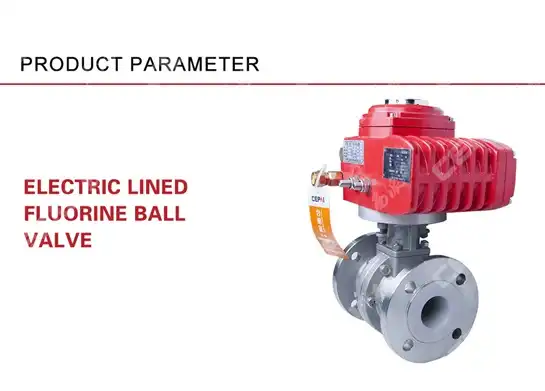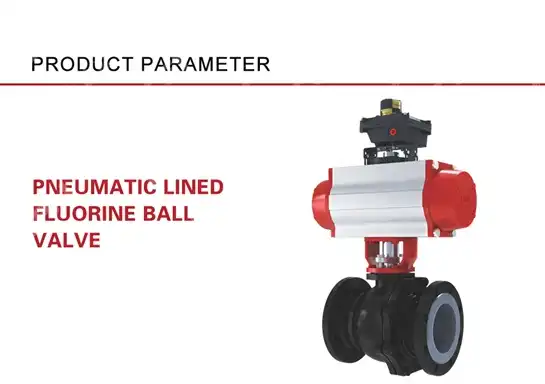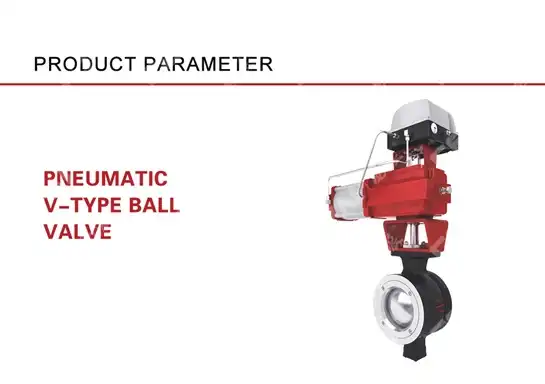Cast Steel Pneumatic V-Shaped Ball Valve vs O-Type: Which Is Better
When your production line experiences pressure fluctuations, inconsistent flow control, or frequent maintenance shutdowns, the choice between a Cast Steel Pneumatic V-Shaped Ball Valve and an O-Type valve becomes critical. The V-Shaped design delivers superior throttling capabilities with a 100:1 adjustable ratio, making it ideal for precision flow regulation in demanding industrial applications. This comprehensive guide examines structural differences, performance characteristics, and application scenarios to help you select the optimal valve solution that minimizes downtime and maximizes operational efficiency.
Understanding the Core Structural Differences Between V-Type and O-Type Ball Valves
The fundamental distinction between Cast Steel Pneumatic V-Shaped Ball Valves and O-Type configurations lies within their internal geometry and operational mechanics. O-Type ball valves feature a spherical ball element with a cylindrical through-hole that aligns with the pipeline diameter, enabling full-bore flow passage when fully opened. This straightforward design excels in applications requiring simple on-off control with minimal pressure drop. The ball rotates ninety degrees between fully open and fully closed positions, providing quick actuation and reliable shut-off capabilities in both directions. In contrast, Cast Steel Pneumatic V-Shaped Ball Valves incorporate a precisely machined V-notch profile on the ball element, creating a contoured opening that interacts progressively with the valve seat during rotation. This sophisticated geometry transforms the valve into a high-performance regulating device capable of delivering linear flow characteristics throughout its operating range. The V-shaped opening gradually increases the flow area as the valve opens, providing exceptional control precision that O-Type valves cannot match. When pneumatic actuators drive these cast steel constructions, operators gain responsive throttling performance suitable for automated process control systems demanding accuracy and repeatability.

-
Internal Ball Design and Flow Dynamics
The Cast Steel Pneumatic V-Shaped Ball Valve utilizes advanced computational fluid dynamics principles in its design optimization. The V-notch configuration creates a variable orifice that modulates flow velocity and pressure drop characteristics more effectively than traditional round-port geometries. As the V-shaped ball rotates, the effective flow area changes proportionally to the valve position, generating near-linear flow curves that simplify control loop tuning. This predictable relationship between valve position and flow rate enables precise process regulation across the full operational spectrum, from minimal trickle flows to maximum capacity. Cast steel construction provides the necessary mechanical strength to maintain dimensional stability under extreme operating conditions. The material's superior tensile properties resist deformation from high-pressure differentials, while its excellent thermal conductivity manages heat dissipation during throttling operations. Premium cast steel alloys exhibit enhanced corrosion resistance and erosion tolerance compared to standard carbon steel alternatives, extending service life in aggressive fluid environments containing abrasive particles or corrosive chemicals.
-
Sealing Mechanism Performance Comparison
O-Type ball valves employ floating ball designs with elastomeric seats that compress against the ball surface, creating bubble-tight shut-off through mechanical deformation. This sealing approach works exceptionally well for clean fluids and moderate temperature applications where the elastomer maintains flexibility and resilience. However, the uniform contact pattern around the entire ball circumference can generate higher actuation torque requirements, particularly in larger valve sizes or high-pressure services. Cast Steel Pneumatic V-Shaped Ball Valves typically integrate metal-seated configurations or reinforced soft seats engineered specifically for throttling duty. The V-notch design concentrates sealing forces along the contoured edge where the ball engages the seat, creating effective shut-off while accommodating the repeated wiping action inherent in regulating service. Advanced seat materials resist wear from continuous positioning cycles, maintaining seal integrity throughout extended operational periods that would degrade conventional O-Type valve seats subjected to similar duty cycles.
Performance Advantages of Cast Steel Pneumatic V-Shaped Ball Valves in Flow Control Applications
When industrial processes demand precise flow modulation rather than simple isolation, Cast Steel Pneumatic V-Shaped Ball Valves demonstrate measurable superiority over O-Type alternatives. The inherent rangeability of V-port geometry enables accurate control across flow ranges exceeding one hundred to one, meaning these valves regulate effectively from one percent to full capacity. This extensive turndown capability eliminates the need for multiple parallel valves or complex bypass arrangements that complicate system design and increase maintenance requirements. Process engineers specify Cast Steel Pneumatic V-Shaped Ball Valves for applications where maintaining tight control tolerances directly impacts product quality, energy efficiency, or safety margins. The linear flow characteristic exhibited by properly designed V-port geometries simplifies control system configuration and optimization. Unlike quick-opening or equal-percentage characteristics that require complex compensation algorithms, linear flow curves provide proportional response to valve position changes throughout the operating range. This predictability reduces commissioning time, improves control loop stability, and minimizes process variability. Pneumatic actuation enhances these benefits by delivering rapid response to control signals while maintaining fail-safe positioning through spring-return mechanisms that automatically drive the valve to a predetermined safe state during air supply interruptions.
-
Throttling Performance Under Variable Conditions
Cast Steel Pneumatic V-Shaped Ball Valves excel in applications experiencing fluctuating pressures, temperatures, or flow rates that challenge conventional control valves. The robust cast steel body construction withstands pressure surges and thermal cycling without dimensional changes that would compromise control accuracy. The V-shaped ball element's progressive opening characteristic naturally accommodates varying pressure differentials, maintaining stable control coefficients across different operating points. This stability proves particularly valuable in processes where upstream or downstream conditions vary with production rates, ambient conditions, or equipment cycling. Cavitation and flashing represent significant concerns in liquid throttling applications where pressure reduction occurs across the valve. The Cast Steel Pneumatic V-Shaped Ball Valve's geometry manages these phenomena more effectively than O-Type designs. The V-notch creates a controlled expansion zone where fluid velocity increases gradually rather than through an abrupt orifice, reducing the tendency for vapor bubble formation and collapse. This characteristic extends valve life by minimizing erosive damage to internal components while reducing noise and vibration that can affect connected equipment and structural supports.
-
Integration with Automated Control Systems
Modern Cast Steel Pneumatic V-Shaped Ball Valves integrate seamlessly with distributed control systems through positioners that convert electronic control signals into precise pneumatic pressure adjustments. These intelligent devices provide diagnostic feedback including valve position confirmation, actuator supply pressure monitoring, and predictive maintenance alerts based on performance trending. The combination of V-port flow characteristics with smart positioner technology creates a complete control loop element that matches or exceeds the capabilities of traditional globe-style control valves while offering superior shut-off performance and reduced maintenance requirements. Pneumatic actuation offers inherent advantages in hazardous area classifications where electrical equipment requires expensive explosion-proof enclosures and specialized wiring installations. Plant air systems provide reliable motive power without introducing ignition sources, simplifying safety certifications and reducing capital costs. The Cast Steel Pneumatic V-Shaped Ball Valve's compact footprint and reduced weight compared to equivalent globe valves further decrease installation expenses and structural support requirements, particularly in offshore platforms, elevated pipe racks, or retrofit applications with limited space availability.
Application-Specific Selection Criteria for Optimal Valve Performance
Selecting between Cast Steel Pneumatic V-Shaped Ball Valves and O-Type configurations requires systematic evaluation of process requirements, operating conditions, and performance expectations. O-Type ball valves remain the preferred choice for applications requiring only isolation service with infrequent operation, where their simple construction, low cost, and reliable shut-off characteristics provide adequate functionality. These valves handle clean liquids and gases effectively in services where precise flow control is unnecessary, such as manual block valves, emergency shut-off devices, or sample point isolation. Cast Steel Pneumatic V-Shaped Ball Valves become the superior selection when applications demand continuous throttling, frequent position changes, or accurate flow proportioning. Chemical processing plants utilize these valves for reactor feed control, product blending, and heat exchanger bypass regulation where maintaining precise ratios directly affects product specifications and yield. Power generation facilities employ V-port ball valves in condensate systems, feedwater regulation, and auxiliary cooling circuits where efficiency optimization requires responsive control across varying load conditions. Oil and gas operations specify Cast Steel Pneumatic V-Shaped Ball Valves for wellhead production control, pipeline pressure regulation, and gas lift systems where harsh environments demand rugged construction combined with precise actuation.
-
Material Selection and Corrosion Resistance Considerations
Cast steel composition significantly influences long-term valve performance and maintenance costs. Standard carbon steel castings provide adequate service in non-corrosive environments with moderate temperatures, offering economical solutions for water service, compressed air systems, and hydrocarbon applications without sulfur compounds or water contamination. Low-alloy cast steels incorporating chromium and molybdenum enhancements resist sulfidation and high-temperature oxidation, making them suitable for refinery applications, steam systems, and high-temperature oil service. Stainless steel castings deliver superior corrosion resistance in chemical processing, pharmaceutical manufacturing, and food grade applications where product purity requirements prohibit contamination from valve materials. Austenitic stainless grades maintain ductility at cryogenic temperatures while resisting stress corrosion cracking in chloride-bearing environments. The Cast Steel Pneumatic V-Shaped Ball Valve's precision-machined internal surfaces benefit from stainless steel's inherent smoothness and cleanability, reducing particle entrapment and simplifying sanitary validation procedures in regulated industries.
-
Sizing Methodology and Pressure Drop Calculations
Proper valve sizing ensures the Cast Steel Pneumatic V-Shaped Ball Valve operates within its design envelope, avoiding undersizing that causes excessive pressure drop, noise, and erosion, or oversizing that restricts controllability at low flow rates. Engineering calculations incorporate flow coefficients specific to V-port geometries, accounting for the non-linear relationship between valve position and effective flow area. Software tools provided by manufacturers streamline these calculations, generating sizing recommendations based on fluid properties, operating conditions, and control requirements. Pressure drop considerations extend beyond simple flow capacity to encompass energy consumption implications and downstream equipment protection. The Cast Steel Pneumatic V-Shaped Ball Valve's efficient flow path minimizes unnecessary energy dissipation in services where pump or compressor power represents significant operating costs. Simultaneously, controlled pressure reduction protects sensitive downstream equipment from excessive pressures while managing potential cavitation or flashing conditions that could damage piping systems or create operational hazards.

Maintenance Requirements and Lifecycle Cost Analysis
Long-term ownership costs significantly influence valve selection decisions, particularly in large-scale industrial facilities operating hundreds or thousands of control points. Cast Steel Pneumatic V-Shaped Ball Valves typically demonstrate lower lifecycle costs compared to traditional sliding-stem control valves despite potentially higher initial purchase prices. The quarter-turn actuation mechanism requires fewer moving parts than linear actuators, reducing mechanical wear and extending service intervals. Ball-type trim components resist process buildup and contamination more effectively than plug-and-seat arrangements that can seize from deposits or corrosion products. Routine maintenance procedures for Cast Steel Pneumatic V-Shaped Ball Valves focus primarily on pneumatic components including actuator diaphragms, supply air filters, and positioner calibration verification. The valve body itself often remains in service for decades with only periodic packing adjustments and stem seal replacement. This durability contrasts sharply with O-Type ball valves subjected to throttling service beyond their design intent, which experience accelerated seat wear, increased leakage rates, and eventual catastrophic failure requiring unplanned shutdowns and emergency replacement.
-
Predictive Maintenance Capabilities and Reliability Enhancement
Advanced Cast Steel Pneumatic V-Shaped Ball Valve assemblies incorporate diagnostic features that enable condition-based maintenance strategies. Intelligent positioners monitor actuator response times, position accuracy, and supply pressure requirements, detecting performance degradation before functional failures occur. This proactive approach optimizes maintenance resource allocation, scheduling interventions during planned outages rather than responding to unexpected breakdowns that disrupt production schedules and compromise safety margins. Process industries implementing reliability-centered maintenance programs recognize Cast Steel Pneumatic V-Shaped Ball Valves as critical control elements warranting systematic monitoring and preventive service. Vibration analysis identifies bearing wear or mounting problems, while periodic performance testing verifies control accuracy and shut-off integrity. These practices maximize equipment availability and process capability, directly supporting operational excellence initiatives focused on minimizing unplanned downtime and maintaining consistent product quality.
Conclusion
Cast Steel Pneumatic V-Shaped Ball Valves outperform O-Type alternatives in applications requiring precision flow control, delivering superior rangeability, linear characteristics, and durability under demanding throttling conditions. While O-Type valves serve effectively in simple isolation duties, V-port configurations provide the regulation capabilities essential for optimized process control.
Cooperate with CEPAI Group Co., LTD.
Partner with CEPAI Group Co., LTD., your trusted China Cast Steel Pneumatic V-Shaped Ball Valve manufacturer and supplier. Our intelligent manufacturing facilities produce High Quality Cast Steel Pneumatic V-Shaped Ball Valves backed by API certifications and ISO quality systems. Whether seeking Cast Steel Pneumatic V-Shaped Ball Valve for sale or competitive Cast Steel Pneumatic V-Shaped Ball Valve price quotations, our China Cast Steel Pneumatic V-Shaped Ball Valve factory delivers exceptional value. As a leading China Cast Steel Pneumatic V-Shaped Ball Valve wholesale provider, we offer comprehensive pre-sales consultation, customization services, and responsive after-sales support. Contact CEPAI today at cepai@cepai.com to discuss your specific requirements and experience the CEPAI difference in precision flow control solutions.
References
1. "Pneumatic Control Valves: Design, Selection, and Applications" - Smith, John R., Industrial Press Engineering Series
2. "Cast Steel Metallurgy for High-Performance Valve Applications" - Chen, Wei and Thompson, David, Journal of Materials Engineering
3. "Ball Valve Technology: Modern Designs and Performance Optimization" - Anderson, Robert J., Valve Manufacturers Association Technical Publication
4. "Flow Control Systems: Principles, Design, and Implementation" - Martinez, Carlos E., Process Control and Instrumentation Handbook

Get professional pre-sales technical consultation and valve selection services, customized solution services.

About CEPAI


